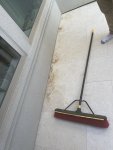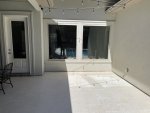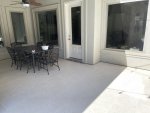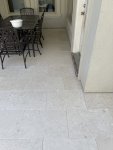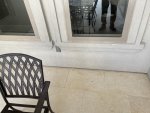We have a "seashell" Trav pool deck, and it was installed in Dec. (Less than 3 months), and we have developed very similar findings on our pool deck as well. We were recommended to allow the stone to "weather" before sealing to address a few color disparities in the stone.
In that time frame or mid-December to date, we have developed the stains.
A little background is that we have a concrete base, so NO sand or limestone underneath our pool deck or patio.
Mason sand was used as the substrate for leveling and setting the pavers, and then a "poly" sand was used to fill the gaps. First, the poly sand has all but washed out, and there is very little sand, if any b/w a lot of our pavers, and with this and rain, we get a lot of the set sand washing out onto the pool deck and into the pool for that matter. The stained pavers are UNDER covered areas or very close and adjacent to the patio's covered area. As others have mentioned, areas in the open and a lot of direct sun look fine.
Someone commented on the iron or mineral content within the sand causing the staining, and I believe this to be the most likely rationale for this happening. With the recommendation of the vapor barrier and white sand or washed and screened sand to help decrease this.
Has anyone had any experience or completed or had their stone installer accept responsibility and complete this step with any success in preventing a recurrence of the staining?
In that time frame or mid-December to date, we have developed the stains.
A little background is that we have a concrete base, so NO sand or limestone underneath our pool deck or patio.
Mason sand was used as the substrate for leveling and setting the pavers, and then a "poly" sand was used to fill the gaps. First, the poly sand has all but washed out, and there is very little sand, if any b/w a lot of our pavers, and with this and rain, we get a lot of the set sand washing out onto the pool deck and into the pool for that matter. The stained pavers are UNDER covered areas or very close and adjacent to the patio's covered area. As others have mentioned, areas in the open and a lot of direct sun look fine.
Someone commented on the iron or mineral content within the sand causing the staining, and I believe this to be the most likely rationale for this happening. With the recommendation of the vapor barrier and white sand or washed and screened sand to help decrease this.
Has anyone had any experience or completed or had their stone installer accept responsibility and complete this step with any success in preventing a recurrence of the staining?


